Sambelong Memories: Herping In The Rainforests Of Great Nicobar
First published in Sanctuary Asia,
Vol. 43
No. 4,
April 2023
Sambelong is the old name for the southern islands in the Nicobar archipelago. These islands are home to numerous endemic species, which thrive in the secrecy of dark forests, protected so far by the blissful absence of modern civilisation. If this rich ecosystem is disturbed and degraded, we stand to lose diverse species, some of which may not even have been recorded, says researcher and herpetologist S. Harikrishnan.
The torrential rain had subsided a little as Boudha Ram and I walked back from our night survey along the East-West Road in Great Nicobar Island. Torch lights illuminated frogs hopping across the broken road. There was much activity in this roadside pool. Most were chorus-calling, tiny Nicobar narrow-mouthed frogs Microhyla nakkavaram. A few Nicobar tree frogs Polypedates insularis were perched on bushes around the pool. Both species are endemic to these islands. We saw a couple of dark grey triangle-spotted keelback snakes Xenochrophis trianguligerus, one in the water and the other in the wet grass around the little pool, possibly hunting for frogs. As I turned away after taking a few photographs, my torchlight illuminated another large, dark snake on the far side of the road. It was moving slowly down the side of the hill. It was an unusually large triangle-spotted keelback, I thought, and as I moved closer, I expected it to turn and bolt back up into the bushes at any moment, the usual behaviour of keelbacks. Instead, this snake froze. I took a few more steps toward it, illuminating it well. To my surprise, instead of fleeing, the snake raised its head, throwing its body into deep s-shaped coils, puffing up its neck and slightly opening its mouth. The message in its loud hiss was clear: back off, I’m not a little water snake. Closer examination showed it to be an unknown member of the rat snake/racer group Coelognathus sp.
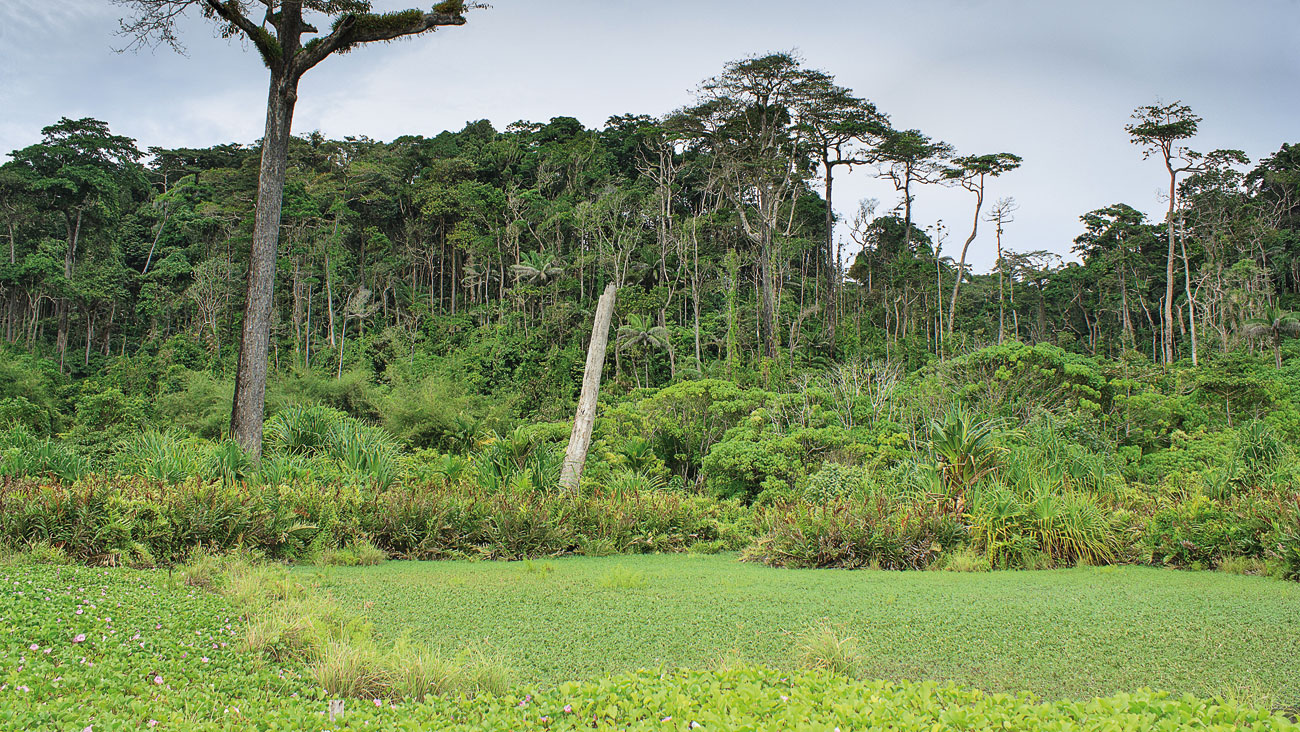
The reptilian and amphibian fauna of the forests of the Nicobar Islands are not only different from mainland fauna, but also abundant. Many species also have island-specific adaptions different from other populations. Photo: S. Harikrishnan.
I first set foot on Great Nicobar Island on a rainy morning in May 2008. I was on a Wildlife Institute of India project, to survey and study the effects of the 2004 tsunami on the herpetofauna of these islands. Historically, islands have had a tendency to hook naturalists. My case was no different. I went to these islands for a one-year project with about six months of field surveys, but ended up spending most of the next six years travelling the islands. There were many things about the reptile and amphibian fauna here that roused my curiosity. Yes, they were different from mainland Indian fauna, but I was also struck by how abundant animals were in the forests of the Nicobar Islands. Groups of islands tended to have species unique to them, and many species were found only on one or two islands. Even the fairly widespread species seemed to have island-specific adaptations different from other populations. Millions of years of isolation from continents, repeated connections as well as breaks between groups of islands, have shaped their fauna. There were, and still are, many ecological and evolutionary phenomena to unpack here.
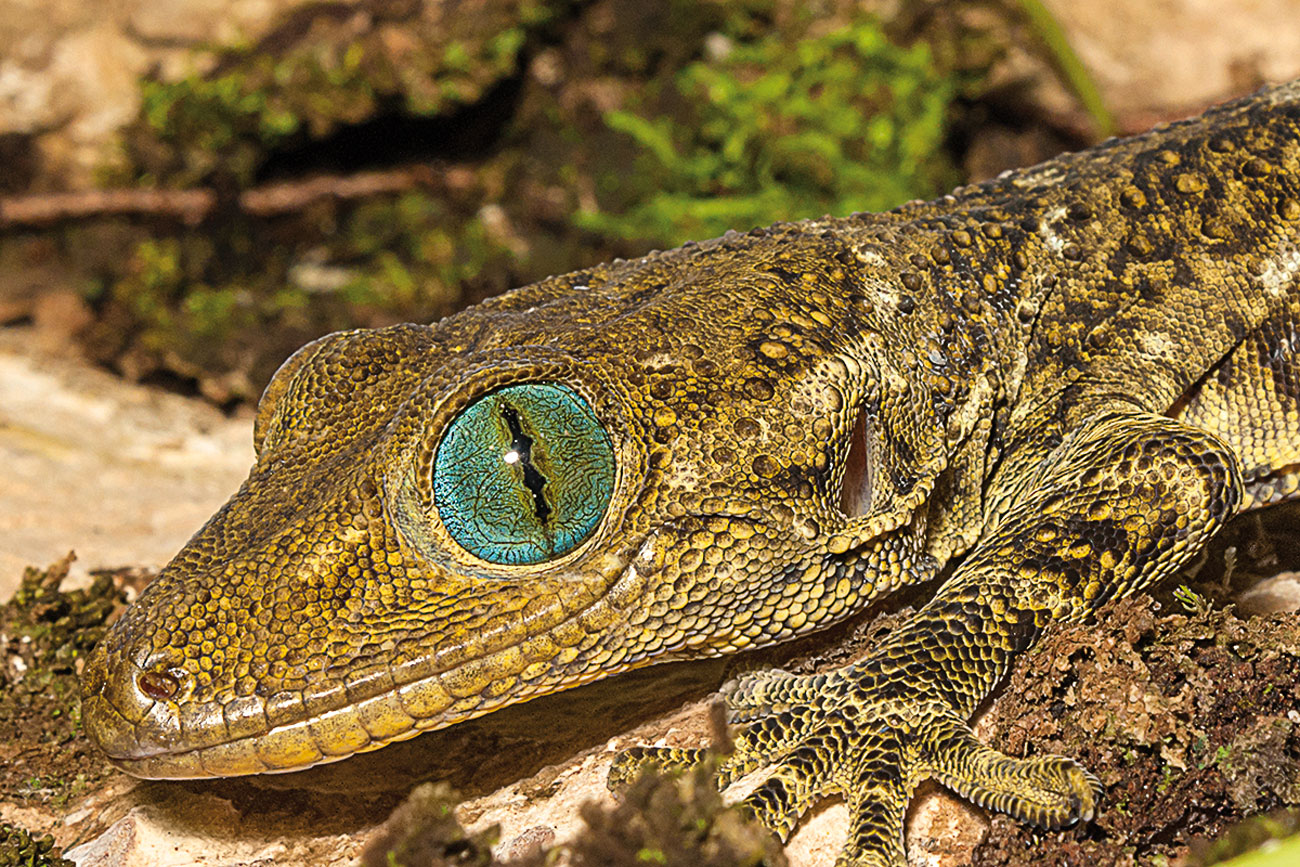
The ‘tok-tok’ calls of the large, nocturnal Stoliczka’s giant gecko Gekko stoliczkai can be heard from kilometres away. These bright blue-green eyed geckos live on large rainforest trees, often in pairs. Photo: S. Harikrishnan.
Herp Paradise
The largest and southernmost island in the Nicobar Archipelago, Great Nicobar Island, is a treasure trove of biodiversity.The island is home to exceptionally diverse and true rainforests, marked by rainfall almost throughout the year. A striking feature of most islands in the Nicobars is the abundance of venomous pit vipers. Five species of pit vipers occur in the northern and central groups of islands, where they are still common in the forests. However, Great Nicobar is an exception. The tall, mighty forests of Great Nicobar seem to have no venomous snakes: no vipers, no cobras and no kraits (not counting sea snakes and sea kraits). This is a highly unusual situation in an Asian rainforest! The closest to a venomous snake here is the large and beautiful Nicobar cat snake Boiga wallachi, which, as the name implies, is found nowhere else in the world. I frequently encountered this snake hunting for frogs at night in bushes surrounding pools. Locals told me that this snake often raids chicken cages in search of eggs. Another well-known chicken thief is the longest snake in the world, the reticulated python Malayopython reticulatus. On occasion, I spotted small individuals climbing up trees into the canopy, probably to hunt roosting birds and bats.
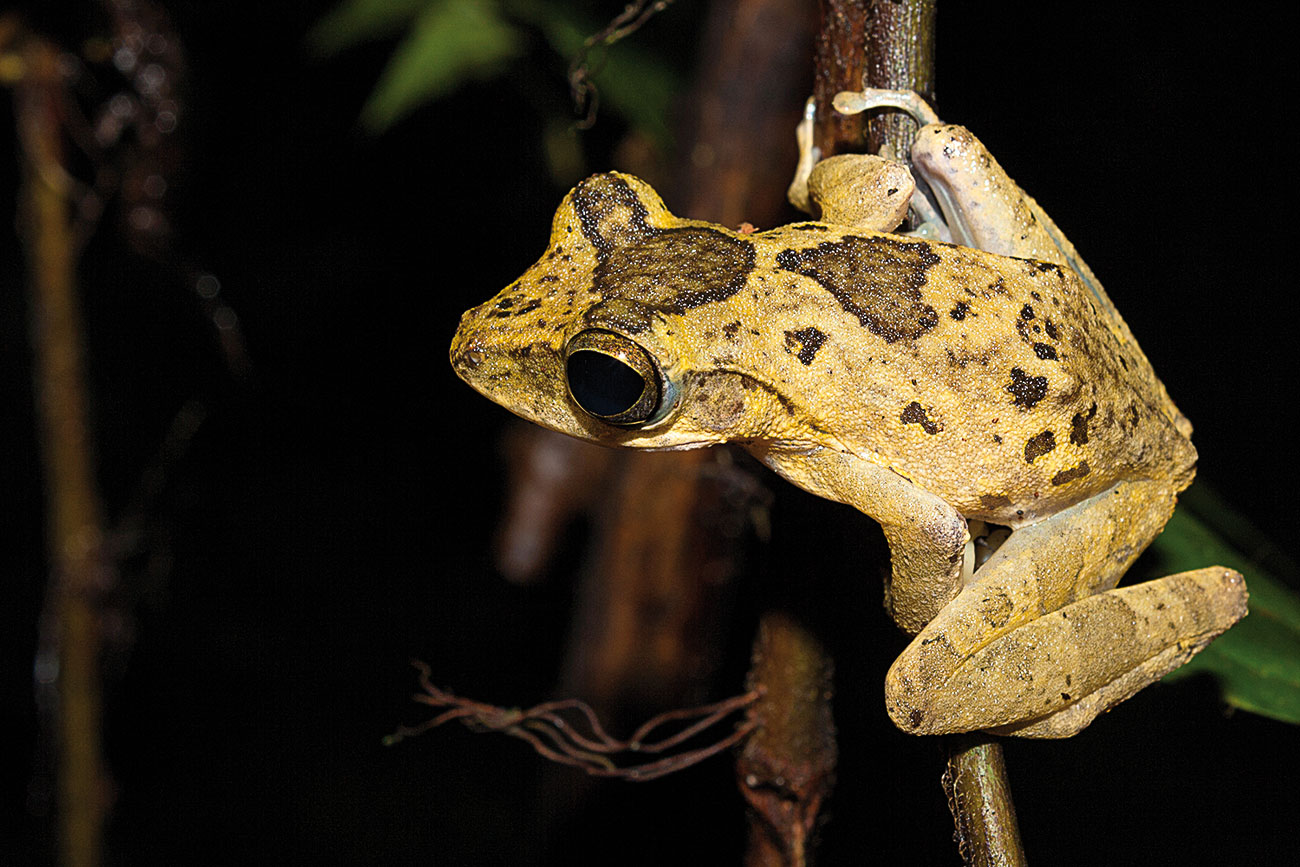
The red-eared frog Hylarana erythraea can be seen along forest edges and pools along the coastal littoral region while the Nicobar tree frog Polypedatus insularis is seen on trees and bushes. Coastal land subsidence and saltwater intrusion on account of the December 2004 tsunami impacted prime amphibian habitats such as wetlands and pools. Photo: S. Harikrishnan.
These forests also have an abundance of much smaller, equally beautiful critters found nowhere else in the world. Along the forest edges and up in the canopy, a ubiquitous sight is the bright green, well-camouflaged Daniel’s forest lizard Bronchocela danieli. On sunny days, one could see males with their black and orange face masks displayed from tree trunks, head bobbing and performing push-ups to intimidate rival males and to attract females. They also keep a sharp eye out for predators, like the fast and slender Humayun’s bronzeback tree snake Dendrelaphis humayuni. In the evenings, the ‘tok-tok’ calls of the large, nocturnal Stoliczka’s giant geckos Gekko stoliczkai could be heard from kilometres away. These foot-long geckos with bright blue-green eyes and a vice-like bite live on large rainforest trees, often in pairs. Down in the gloom of the understorey and leaf litter are other inhabitants. I often saw the slender Nicobar bent-toed gecko Cyrtodactylus adleri that rests during the day under leaf litter, climbing up on tree trunks and saplings at night. When spotted, they use their zebra-striped tails to distract would-be predators by wriggling it like a little worm. Foraging in leaf-litter and humus is a little brown snake, which reveals all the colours of the rainbow only when placed in bright light, earning it the name sunbeam snake Xenopeltis unicolor. The scales of this snake are so smooth and shiny that local people call it ‘telsanp’ (oil snake). I remember searching for it all day long in the forest without ever finding one, only to have it slither across the road right in front of me while I walked back to camp. It shares the rich humus layer of the forest with another small reptile, the Nicobar worm lizard Dibamus nicobaricus. Worm lizards are a unique family of lizards that have lost their hands and legs as adaptation to a burrowing life. Though their pointed snout, scale covered eyes, and elongated body makes them look like a burrowing snake, one can still see two little flaps of skin, especially in males, where the legs used to be.
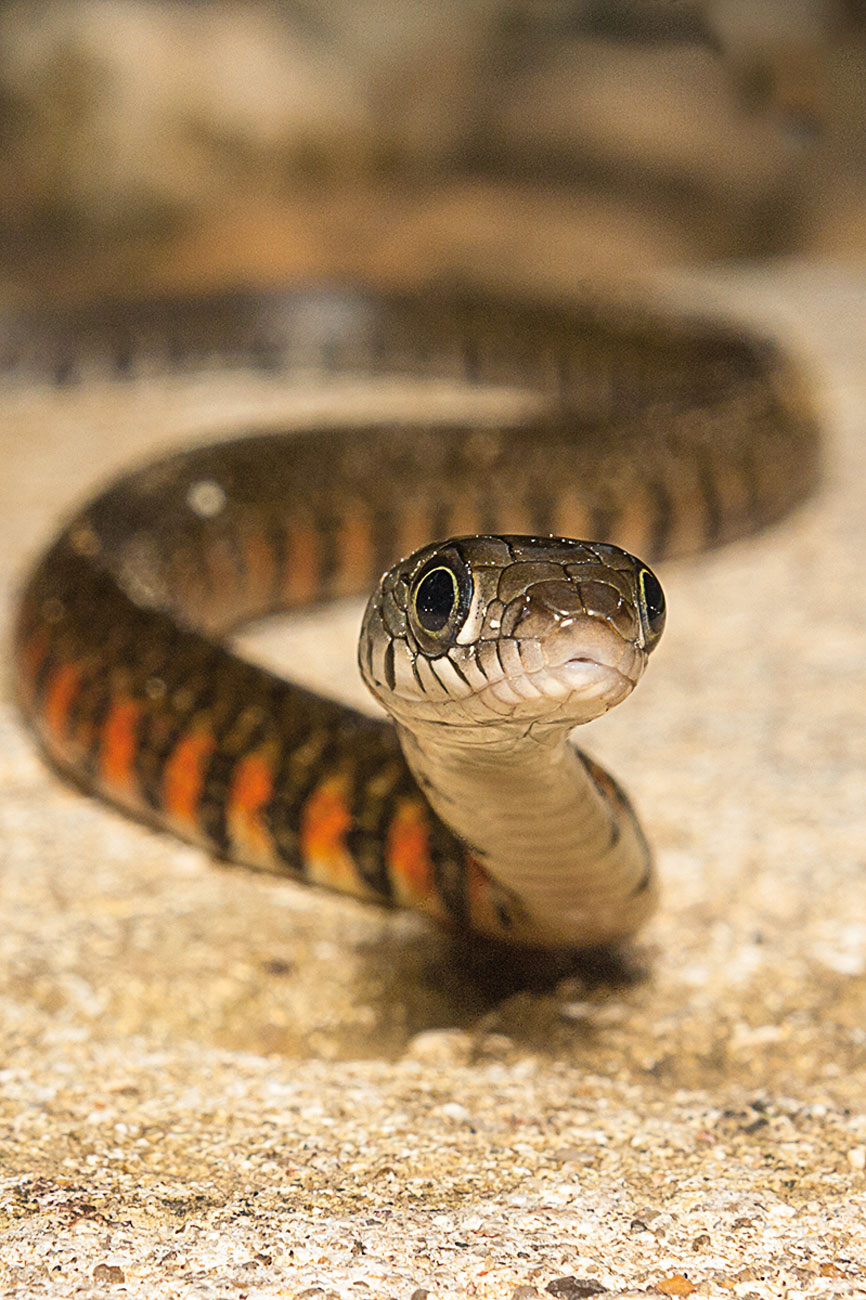
The triangle-spotted keelback snake Xenochrophis trianguligerus and the fast and slender Humayun’s bronzeback tree snake Dendrelaphis humayuni are skilled predators that feed on lizards and frogs as does the sunbeam snake Xenopeltis unicolor that forages in leaf-litter and humus. The latter appears to be brown until placed in bright light, when its skin reveals all the colour of the rainbow. Photo: S. Harikrishnan.
Amphibian Hunt
On rainy nights, the forests reverberate with the calls of many frogs. Largest among the frogs that inhabit this island is the Shompen frog Limnonectes shompenorum. These frogs are named after the Shompens, the Indigenous people who they have shared this forest with for hundreds of years. These frogs seem to prefer the dark forest understorey and are commonly seen along perennial streams that criss-cross the forest. Unlike most frogs, they do not call often, though on occasion, one may hear a single loud ‘baarrk’ coming from under an old log in a stream. It shares the forest’s streams with several other frog species, including its much smaller and colourful cousin, the Nicobar cricket frog Minervarya nicobariensis. On forest edges and pools along the coastal littoral region lives the red-eared frog Hylarana erythraea. The habitat of this frog, wetlands and pools along the coastal region of Nicobar Islands, underwent massive destruction during the tsunami that hit the islands in December 2004. Particularly damaging was the subsidence of coastal land and intrusion of salt water. However, the frogs managed to survive the catastrophe and are still fairly common.
_C-1300_1680685837.jpg)
The triangle-spotted keelback snake Xenochrophis trianguligerus and the fast and slender Humayun’s bronzeback tree snake Dendrelaphis humayuni are skilled predators that feed on lizards and frogs as does the sunbeam snake Xenopeltis unicolor that forages in leaf-litter and humus. The latter appears to be brown until placed in bright light, when its skin reveals all the colour of the rainbow. Photo: S. Harikrishnan.
The Herpetofauna of Great Nicobar Island
There are 34 species of terrestrial amphibians and reptiles (not including the several species of sea snakes, sea turtles and salt water crocodiles) known from Great Nicobar Island. At least 15 of these are endemic to the Nicobar Islands, particularly to Great and Little Nicobar. Many of these were previously thought to be widespread species, but focused studies using modern tools have revealed them to be endemic to these islands. If this pattern holds true, more and more species are likely to be endemic to these islands than currently understood.
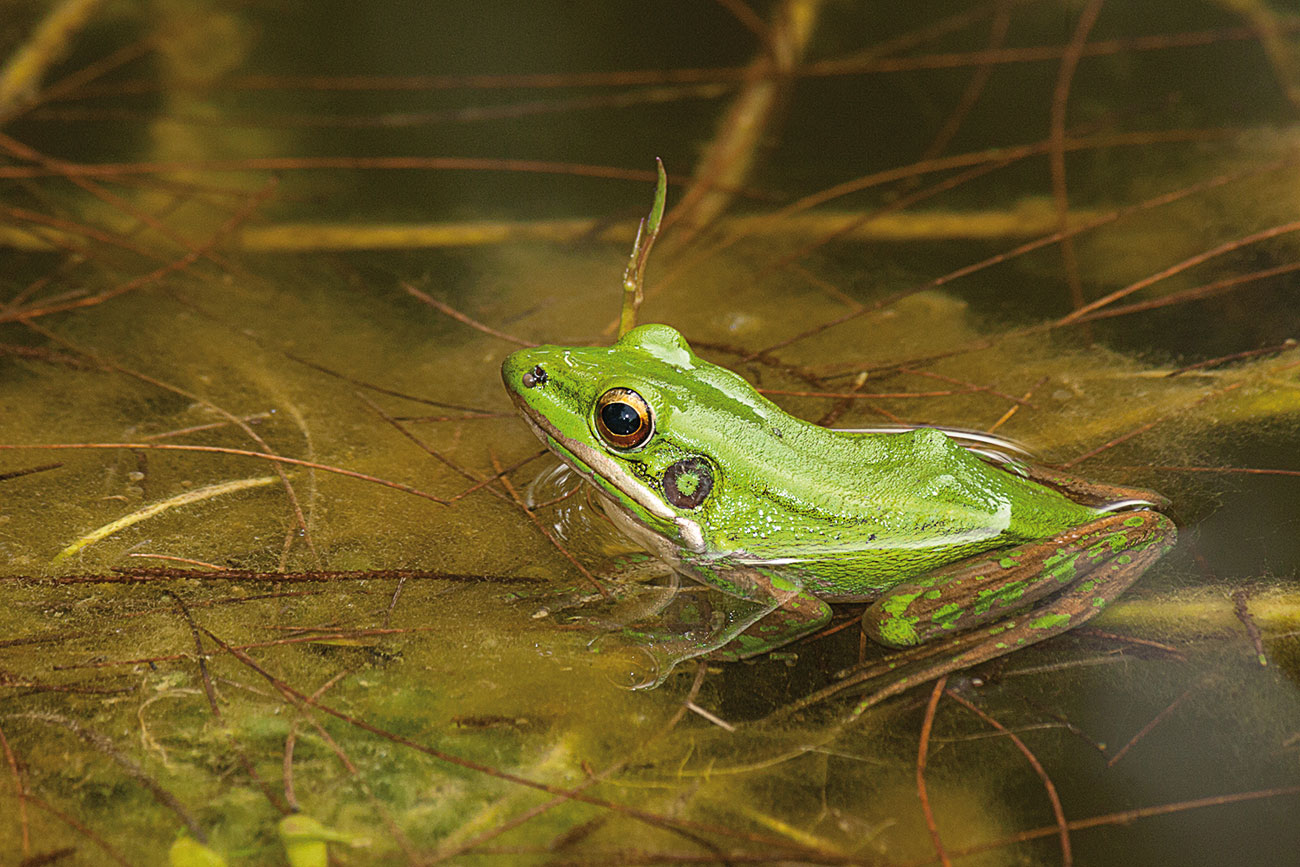
The red-eared frog Hylarana erythraea can be seen along forest edges and pools along the coastal littoral region while the Nicobar tree frog Polypedatus insularis is seen on trees and bushes. Coastal land subsidence and saltwater intrusion on account of the December 2004 tsunami impacted prime amphibian habitats such as wetlands and pools. Photo: S. Harikrishnan.
A Long Lost Skink
The forests of Great Nicobar (and Little Nicobar) in the southern part of the Nicobar island archipelago are some of the least explored and studied in the world. Since the middle of the 19th Century, several scientific expeditions have been undertaken in this group of islands. Invariably, every single such effort has produced species new to science, though often well-known to the Indigenous people. In March 1858, the Novara expedition by the erstwhile Austrian Imperial Navy visited Great Nicobar during their expedition around the world. Among the several species they recorded was a small skink collected from near Galathea Bay, which they named Euprepes macrotis (now known as Scincella macrotis, the large-eared skink). No scientist seems to have seen another one of this species yet, a little lizard that has been lost for over 160 years.
So, I went looking for it. On a December evening in 2012, after a day-long search along the Galathea coast, my friend Anand James and I had climbed the ridges to the east of the Bay on our way home. On looking back, I saw the turbulent waters of the bay, being brought in by the rising tide. To our right was the beautiful forest of the Galathea Wildlife Sanctuary extending in a long curve around the bay, the dark line of the forest on the far side of the bay separated from water by a thin white line of sandy beach. Clouds were gathering, the wind had picked up, and we had to get back to camp. We had not found the lost skink, but my heart was happy, for I knew that this place was safely far away from the clasps of modern civilisation.
_C-1300_1680686072.jpg)
The triangle-spotted keelback snake Xenochrophis trianguligerus and the fast and slender Humayun’s bronzeback tree snake Dendrelaphis humayuni are skilled predators that feed on lizards and frogs as does the sunbeam snake Xenopeltis unicolor that forages in leaf-litter and humus. The latter appears to be brown until placed in bright light, when its skin reveals all the colour of the rainbow. Photo: S. Harikrishnan.
How wrong I was! The Galathea Bay Wildlife Sanctuary was de-notified in January 2021. The forests of Galathea Bay area, where the large-eared skink was discovered, where giant leatherback sea turtles come to nest every year, is set to be cleared, to make way for a transhipment port. If a 1.5 m.-long snake and a small lizard could both remain undiscovered in the forests of Great Nicobar, how many more such elusive species are there? We may never know, as a large chunk of the forests of Great Nicobar is soon to be cleared, and more is likely to follow. The true magnitude of this loss cannot be measured.
S. Harikrishnan, PhD., is a Research Associate at the Centre for Ecological Sciences, Indian Institute of Science, Bengaluru.






_C-1300_1680685837.jpg)

_C-1300_1680686072.jpg)